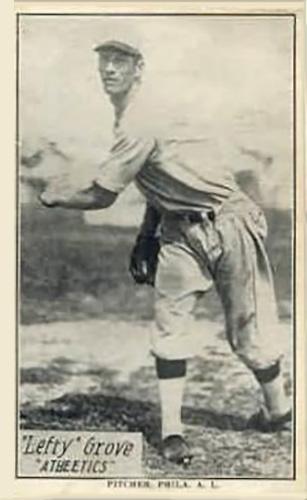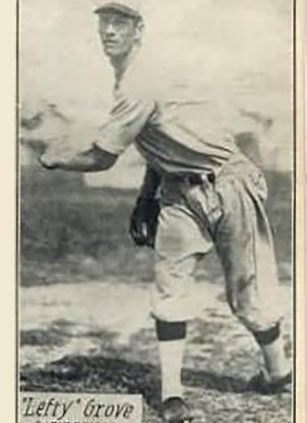June 3, 1929: Lefty Grove, George Uhle battle into extra innings
 Something had to give as the league-leading Philadelphia Athletics and their ace, Lefty Grove, took on undefeated hurler George Uhle and the Detroit Tigers. The streaking Athletics had won five games in a row and 16 of 17, to open up a 5½-game lead atop the American League standings, with a 30-9 record. Grove was having another outstanding season, coming into the game with a 7-1 record and a 2.34 ERA.
Something had to give as the league-leading Philadelphia Athletics and their ace, Lefty Grove, took on undefeated hurler George Uhle and the Detroit Tigers. The streaking Athletics had won five games in a row and 16 of 17, to open up a 5½-game lead atop the American League standings, with a 30-9 record. Grove was having another outstanding season, coming into the game with a 7-1 record and a 2.34 ERA.
The Tigers, on the other hand, were 24-22, and in fourth place. However, George Uhle had been dominating. He’d won every one of his starts, going 9-0 with a 1.86 ERA.1 Two games before, he’d thrown an eye-popping 20 innings to defeat the Chicago White Sox. In order to earn his 10th consecutive victory he’d have to beat Grove and the high-flying A’s.
Even though Detroit was struggling, and had dropped the first two games of the series, Athletics manager Connie Mack had a favorable opinion of the Tigers and their ability to turn their fortunes around. Mack told the Detroit Free Press, “I believe now that it is the club that we will have to beat if we win the pennant.”2
The much anticipated third game of the series began as expected, as Grove “throttled the Tiger side in order at the outset.”3 In the Athletics half of the inning, Uhle “started like a mowing machine working on a field of grass” as he struck out the first two hitters he faced and retired the side in order.4
The first hit of the game came in the second inning, when A’s cleanup hitter Al Simmons, who was batting .357, “birched a single to right.”5 After taking second on a passed ball, Simmons was sacrificed to third, and Uhle faced his first big test of the afternoon, as 21-year-old Jimmie Foxx strode to the plate with a runner at third and one down. Foxx was having a terrific season, entering the game with a .422 batting average and 9 home runs. However, Uhle fanned the slugger on an inside curve and got Bing Miller to fly out to left field to get out of the inning.
Grove didn’t allow a baserunner until the fourth inning, when his “complete mastery over the Tigers” was finally solved.6 After Roy Johnson struck out on three pitches, Harry Rice doubled to left field and Charlie Gehringer singled to bring home the game’s first run. However, Foxx cut the throw to the plate, fired the ball to second and Max Bishop slapped the tag on Gehringer for the second out. Grove got out of the inning by inducing Harry Heilmann to ground out to short.
A poor throw by Uhle in the fifth inning proved to be costly. Miller led the inning off with a single and Jimmy Dykes attempted to advance him by dropping down a bunt. Uhle fielded the ball and fired a low throw to second that shortstop Heinie Schuble was unable to handle. Both runners were safe and Uhle was charged with an error. The Detroit Free Press wrote that the “misplay could have been converted into an out had not Schuble failed to handle cleanly a ball that bounded perfectly into his hands.”7 Grove sacrificed the runners up a base. Max Bishop then grounded out to second and Miller raced home with the A’s first run. Mule Haas continued the rally with a single to center “just out of Rice’s reach” to give Philadelphia its first lead of the game, 2-1.8 Because of Uhle’s error, both runs were unearned.
The Tigers scratched out a run off Grove in the seventh to tie the score. Charlie Gehringer drew a one-out walk and went to third on Heilmann’s single to left. Dale Alexander “chopped a high bounder”’ shortstop Jimmy Dykes fielded it and fired a “smoking throw” to get the runner at first.9 But Gehringer crossed the plate to knot the score, 2-2.
The teams remained deadlocked as the game moved into extra innings, with both pitchers able to buckle down and work out of jams when necessary. The Free Press wrote that “Uhle was in trouble more consistently than Grove, yet he was the master when it came to getting out of it unscathed.”10 Uhle was also aided by a terrific catch by right fielder Harry Heilmann in the 10th inning. With two down and runners at the corners, Heilmann “saved the game from ending when he made a brilliant catch of (Sammy) Hale’s liner.”11
Both teams threatened to score in the 11th, but failed to bring a run home. Grove walked a pair of batters in the Tigers half of the frame, but Gehringer lined into an inning-ending double play to bail him out. Dykes singled with two down in Philadelphia’s half of the inning. Grove followed that up with a single, and after center fielder Harry Rice bobbled the ball, the runners ended up at second and third. However, Max Bishop grounded one to second base to end the inning and send the game to the 12th.
The A’s finally broke through in the 13th. Jimmie Foxx “rattled the numerals on the scoreboard” for a double to lead off the bottom of the inning, his third hit of the day, raising his average to .425.12 After Foxx was sacrificed to third, Uhle gave Dykes an intentional pass to put runners at the corners with one down. Connie Mack then sent 42-year-old Eddie Collins to the plate to pinch hit for Grove. Uhle “decided to take no chances on the vintage emergency man” and walked Collins to load the bases.13
Max Bishop, known for having a keen batting eye, stepped to the plate with the bases loaded and one out. Bishop was hitting just .238 at the start of the game, but because he had more walks (49) than hits (34), his on-base percentage was .435. Due to his penchant for drawing walks, the Philadelphia Inquirer wrote, “In such a situation, Bishop was perhaps the most dangerous man in the east for Uhle to confront.”14
The first two pitches in the critical at-bat did not portend well for Uhle, as they were both balls. He then delivered strike one, followed by ball three. Bishop watched Uhle’s next pitch go past for strike two, to make the count full. He then took another pitch, which home-plate umpire George Hildebrand judged as low. The bases-loaded walk allowed Foxx to trot home with the winning run, as Uhle “went through a pantomime that registered dissent over the umpire’s decision.”15
The walk brought home the first run Uhle had allowed since the fifth inning, and the first earned run he allowed in the game. The Philadelphia Inquirer wrote that it was “a freakish finale to a rousing battle and it gave the 15,000 spectators an idea of how highly important a base on balls can sometimes loom in these humming days with constant flurries of home runs in every park.”16
The game had lived up to its billing, with both pitchers performing masterfully. Lefty Grove threw 13 innings, allowing two runs on four hits, while striking out seven and walking five. He earned his eighth win against one loss, lowered his ERA to 2.20, and helped lead the A’s to their 17 th win in 18 games.
George Uhle surely deserved a better fate after allowing three runs, just one earned, in 12⅓ innings, but his throwing error in the fifth and the bases-loaded walk in the 13th proved to be his undoing. The right-hander allowed 11 hits in the game while walking six (three intentionally) and striking out six. He took his first loss of the season after nine victories. Harry Bullion in the Detroit Free Press commented, “Uhle should have won today and continued indefinitely to compile his triumphs, but fate stepped in and precluded that.”17
In such a superbly pitched game, perhaps it was fitting that the contest was decided by a single full-count pitch that had to be judged either a ball or strike by the home-plate umpire, rather than a ringing double off the wall or a long home run. The Philadelphia Inquirer’s James Isaminger wrote, “No majestic drive over the wall or into the stands, no booming crash against the fence beat Uhle, but just a meek and colorless base on balls, which under the conditions leaped into tremendous importance. …”18 A game that had been dominated by two pitching aces ultimately came down to a single pitched ball in the 13th inning.
SOURCES
In addition to the sources cited in the Notes, the author consulted Baseball-Reference.com.
NOTES
1 Baseball-Reference has Uhle’s ERA as 1.86. Retrosheet has it at 1.96. The difference stems from his start on May 29 against the St. Louis Browns, when Baseball-Reference charges him with four earned runs, while Retrosheet charges him with five.
2 “Connie Mack Avers Tigers Team to Beat,” Detroit Free Press, June 4, 1929: 22.
3 James Isaminger, “Pass to Max Bishop With Winning Tally Brings Foxx Across,” Philadelphia Inquirer, June 4, 1929: 22.
4 Isaminger.
5 Isaminger.
6 Harry Bullion, “Unearned Tallies Win for Mackmen,” Detroit Free Press, June 4, 1929: 24.
7 Bullion, 21.
8 Bullion, 24.
9 Isaminger.
10 Bullion, 21.
11 Isaminger.
12 Bullion, 21.
13 Isaminger.
14 Isaminger.
15 Isaminger.
16 Isaminger.
17 Bullion, 21.
18 Isaminger.
Additional Stats
Philadelphia Athletics 3
Detroit Tigers 2
13 innings
Shibe Park
Philadelphia, PA
Box Score + PBP:
Corrections? Additions?
If you can help us improve this game story, contact us.


